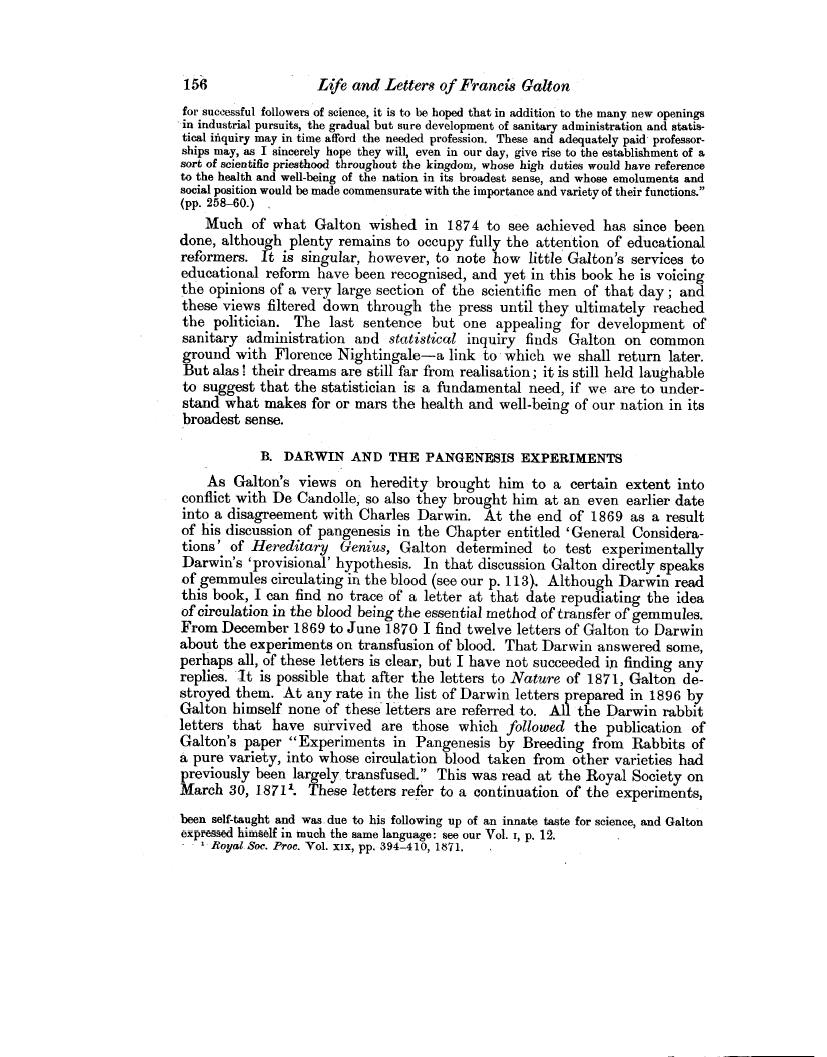156 Life and Letters of Francis Galton
for successful followers of science, it is to be hoped that in addition to the many new openings in industrial pursuits, the gradual but sure development of sanitary administration and statistical inquiry may in time afford the needed profession. These and adequately paid- professorships may, as I sincerely hope they will, even in our day, give rise to the establishment of a sort of scientific priesthood throughout the kingdom, whose high duties would have reference to the health and well-being of the nation in its broadest sense, and whose emoluments and social position would be made commensurate with the importance and variety of their functions."
(pp. 258-60.) Much of what Galton wished in 1874 to see achieved has since been done, although plenty remains to occupy fully the attention of educational reformers. It is singular, however, to note how little Galton's services to
educational reform have been recognised, and yet in this book he is voicing the opinions of a very large section of the scientific men of that day ; and these views filtered down through the press until they ultimately reached the politician. The last sentence but one appealing for development of sanitary administration and statistical inquiry finds Galton on common ground with Florence Nightingale-a link to which we shall return later. But alas ! their dreams are still far from realisation; it is still held laughable to suggest that the statistician is a fundamental need, if we are to under
stand what makes for or mars the health and well-being of our nation in its broadest sense.
B. DARWIN AND THE PANGENESIS EXPERIMENTS
As Galton's views on heredity brought him to a certain extent into conflict with De Candolle, so also they brought him at an even earlier date into a disagreement with Charles Darwin. At the end of 1869 as a result of his discussion of pangenesis in the Chapter entitled `General Considerations' of Hereditary Genius, Galton determined to test experimentally Darwin's `provisional' hypothesis. In that discussion Galton directly speaks of gemmules circulating in the blood (see our p. 113). Although Darwin read this book, I can find no trace of a letter at that date repudiating the idea of circulation in the blood being the essential method of transfer of gemmules. From December 1869 to June 1870 I find twelve letters of Galton to Darwin about the experiments on transfusion of blood. That Darwin answered some, perhaps all, of these letters is clear, but I have not succeeded in finding any replies. -It is possible that after the letters to Nature of 1871, Galton destroyed them. At any rate in the list of Darwin letters prepared in 1896 by Galton himself none of these letters are referred to. All the Darwin rabbit letters that have survived are those which followed the publication of Galton's paper "Experiments in Pangenesis by Breeding from Rabbits of a pure variety, into whose circulation blood taken from other varieties had previously been largely, transfused." This was read at the Royal Society on March 30, 1.871': These letters refer to a continuation of the experiments,
been self-taught and wass due to his following up of an innate taste for science, and Galton expressed himself in much the same language: see our Vol. r, p. 12. _ 1 . Royal.Soc. Proc. Vol. xix, pp. 394-410, 1871.

